In the backhand loop against backspin, the idea is to hit the ball over the net with medium fast to fast speed and and enough topspin to bring the ball down on the other side of the table. More spin can be added if desired, producing a ball that will dip faster and travel slightly slower.
Ready Position

© Greg Letts
Points to look for:
- The feet are placed with the right foot slightly further back than the left foot. This is because there is no weight transference forward, and the slight loss in power caused by having the left foot forward is more than compensated for by already being in the correct stance for a forehand counterhit or loop.
- The weight is evenly distributed on the balls of the feet to allow quicker movement. Too much weight on the heels will slow down movement, and too much weight on the toes will affect balance.
- The knees are bent and the feet are around one and a half times shoulder width apart. The torso is also leaning slightly forward to give better balance and movement.
- Shoulders are in line with the legs.
- The arms are held roughly shoulder width apart, with around a 90 degree angle at the elbow. The bat should be above the table to allow easy stroking of short balls.
Middle Of Backswing
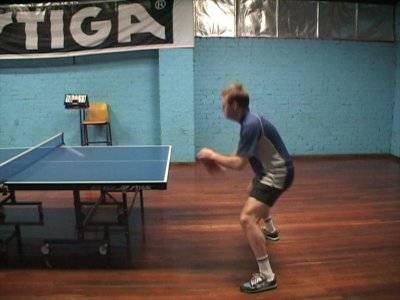
© Greg Letts
The ball is coming to the backhand side and the decision has been made to play a backhand loop. The backswing begins the stroke.
Points to look for:
- The bodyweight of the player is evenly distributed between both legs.
- The hips, waist and shoulders have not begun to turn yet, although the player has crouched a little more, to allow more lifting of the ball during the stroke.
- The head is facing forward watching the ball.
- The bat has only moved slightly backwards at this point. The amount that the bat moves backwards will vary from player to player, and will also be affected by the amount of power the stroke is hit with.
- The left arm has not moved significantly, and will not do so throughout the stroke. Since very little weight is shifting, it is not required to move it for balance, and it is better left in the same position.
End Of Backswing
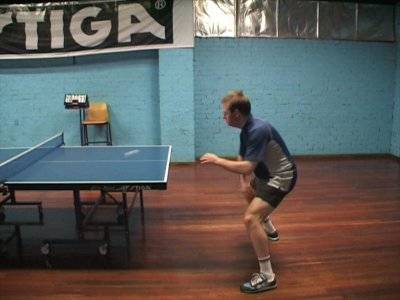
© Greg Letts
The ball has bounced on the table, and the backswing has finished.
Points to look for:
- The bodyweight has moved a little onto the left leg, but is still fairly even.
- The left arm has not moved, and the right arm has bent at the elbow to the left, so that the forearm is parallel to the endline of the table.
- Notice that the shoulders have turned a little more than the hips and waist.
- Both shoulders have lowered a little, as the player continues to get into position. The right hand is below table height. Note that the right hand is not directly underneath the left hand, but is around six inches or so to the right of it horizontally.
- The head has lowered to allow the player to keep watching the ball comfortably and closely.
- The player is directly behind the ball, with the ball between the player’s navel and left hip.
- The angle of the bat is about 45 degrees, with the top edge of the bat pointing halfway between the floor and the camera, with the wrist cocked.
Start Of Forward Swing

© Greg Letts
The player has begun his forward swing.
Points to look for:
- The upper arm has moved first, leading the way.
- The bat has just started to move, lagging behind the movement of the upper arm and elbow.
- The player has begun to straighten his knees and lift out of his crouch, which will help add some lift to the ball when it is struck.
- The player is continuing to watch the ball closely.
- The free arm has remained stationary.
- The right shoulder is now a little in front of the left shoulder, though the feet have not moved at all.
Contact With The Ball
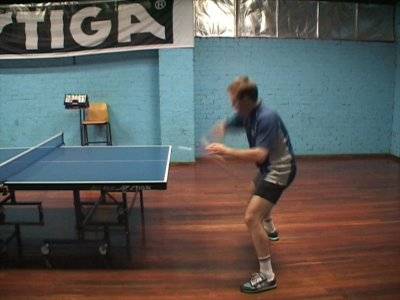
© Greg Letts
Contact is about to be made with the ball.
Points to look for:
- The player is watching the bat contact the ball.
- The hips, waist and shoulders have not turned appreciably from their position at the end of the backswing. They would be turned if extra power was required.
- The player has continued to move upwards out of his crouch, due to the force of the swing.
- The forearm and bat are moving very fast, as shown by the blurring in the photograph. In comparison, the shoulders and waist are hardly turning at all.
- The wrist, which was cocked, has been snapped so that the edge of the bat has travelled in the same direction as the forearm, adding extra speed and spin to the stroke.
- If the ball was compared to a clockface, the bat has made contact at a point roughly around the number 2, while the bat was moving upwards and forwards. Note that the angle of the bat remains at around 45 degrees. This movement makes the ball go mainly forward and a little upwards, with a heavy amount of topspin generated by the brushing of the ball. If more backspin was on the ball, the angle of the stroke would be slightly more upwards, with the bat at a more vertical angle.
- Contact has been made between the left hand side of the torso and the middle of the body.
Middle Of Follow Through
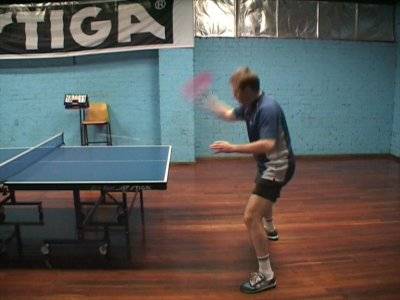
© Greg Letts
The ball has been struck, and the player is in the middle of his follow through.
Points to look for:
- The playing arm has now been allowed to swing to the right once the maximum forward movement was reached, following the natural movement of the right arm.
- The wrist has turned over, as show by the forehand rubber now facing the ceiling. Again, this is the natural movement of the wrist and forearm.
- The free arm is still stationary.
- The player is now out of the crouch, and is fairly upright.
End Of Follow Through
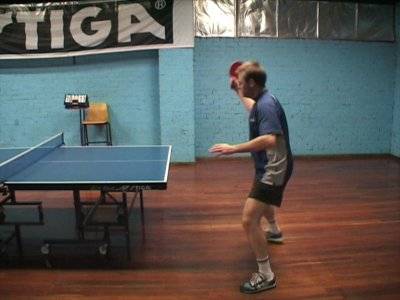
© Greg Letts
The forward swing has come to an end, and the ball is well on its way.
Points to look for:
- The player is now watching his opponent at the other end of the court, rather than the flight of the ball.
- The hips, waist and shoulders have turned to be square to the endline of the table.
- The hips, waist and shoulders are a little higher than the original ready position, since the legs have pushed up a little to help lift the ball.
- The follow through has finished about head level, with the right shoulder moving a little to the right as the bat is halted.
Start of Return to Ready Position
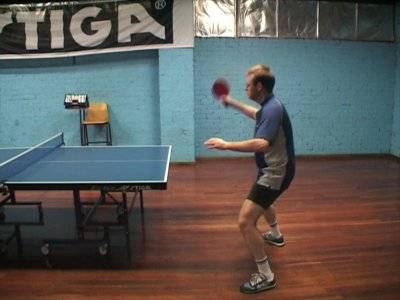
© Greg Letts
The player is now beginning his return to his basic ready position.
Points to look for:
- The bat is being returned to a vertical position, so that it will be ready for either a forehand or backhand stroke.
- The player is returning to his crouch, to allow easy movement in all directions.
Return To Ready Position
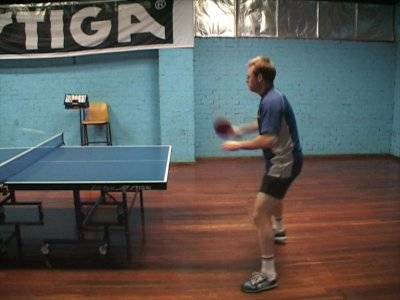
© Greg Letts
The player returns to his ready position before the next stroke.
Points to look for:
- The player has let his right arm drop a little, with a bit of sideways movement, to put his bat back into the ready position. Note that the bat is pointing forward in a neutral position, and is not left in place for another backhand.
- The waist, hips and shoulders have returned to their original position.
- His knees have begun to straighten as he begins to move for his next stroke.
- His bodyweight is again evenly distributed between his left and right legs, and on the balls of his feet. He has also leaned forward a little again.
- His free arm has remained virtually stationary throughout the entire stroke.

